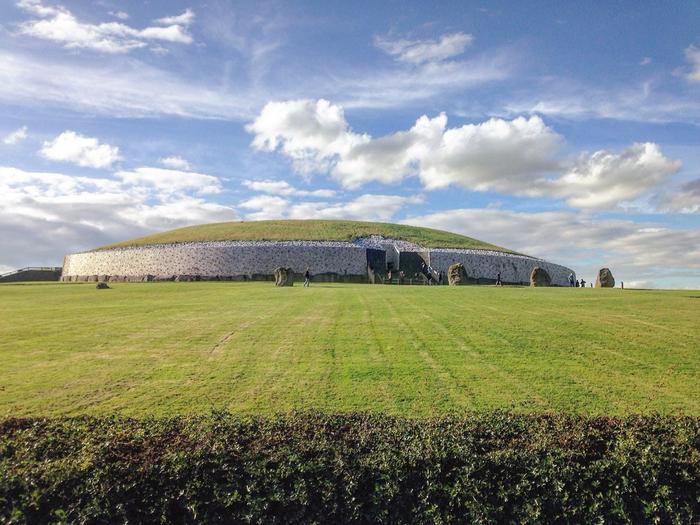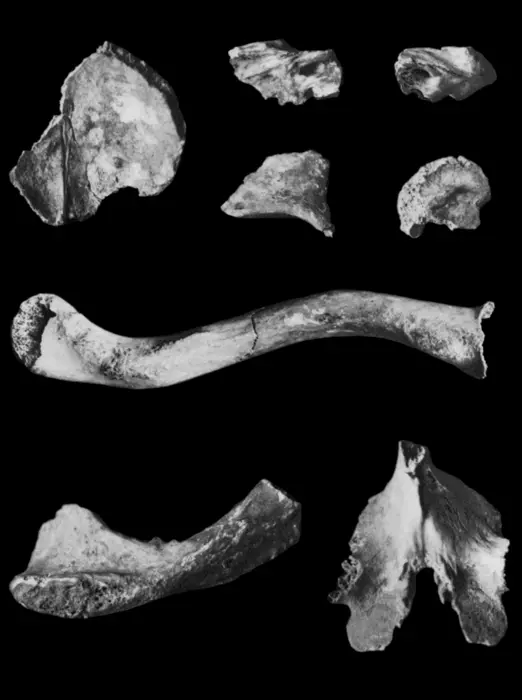Newgrange: study casts doubt on ‘incestuous royalty’ in Neolithic Ireland
New research has cast doubts over suggestions an incestuous social elite ruled over the ancient people of Ireland more than 5,000 years ago.
Researchers examined the evidence from burials of individuals at the Newgrange prehistoric monument in Ireland – a large circular mound containing a chamber where cremated and unburnt human remains were placed, the discovery of which led to speculation that those buried there must have been from an elite class or a royal family.
In 2020, the DNA analysis of a bone skull fragment found in the chamber, however, suggested that at least one of the individuals buried there was the result of a relationship between two siblings or a parent and child, and was also distantly related to others buried in the chamber.
It is believed that only particular individuals were buried in the chamber and therefore they must have held a ‘special’ position in society. The assumption was that if an individual born of incest was placed in the chamber, that this practice must have been ‘accepted’ by society, possibly because it was ‘common’ among a ruling elite.
A research team, including the University of York and University College Dublin, however, have now shown that there is no corroborating evidence in nearby settlements, dietary practices, or trade, that an elite existed either economically or socially.
Researchers now believe the society at the time was more equal, based on the fact that they appeared to share and exchange resources, as well as live in similar dwellings.
Professor Penny Bickle from the University of York’s Department of Archaeology, said:
“The evidence all points to a much more collective ethos. There are not wide disparities in diet, houses are relatively flimsy, and all similar to each other.
“There are no large settlement systems or trade mechanisms, and we also don’t see production of craft on the scale that we see in other ancient societies such as in Ancient Egypt, where incest was thought to be practiced by the ruling elite.”
“We can only begin to understand these monuments and tombs if we examine the social lives or the communities that built and use them, and when we start to do this, this idea of a ‘social elite’ or a form of royalty starts to appear less likely.”
Older than Stonehenge and the Pyramids of Giza, Newgrange is believed to have been built by a farming community that prospered in the Boyne Valley, County Meath, some 5,000 years ago. Newgrange was rediscovered in AD 1699 and its interior had been heavily disturbed prior to its modern excavation in the 1960s, and so researchers question whether this was even the original burial place of the skull fragment, referred to as NG10, dated to 3340 – 3020 BC.

The genetic clustering in passage tombs, such as at Newgrange, typically reflects very distant biological relationships – like second cousins or great-great-great-grandparents – rather than close familial ties. To establish if the tombs were reserved for an elite, researchers say they would expect much closer genetic ties than they have seen at Newgrange.
It is more likely that these tombs were places that reflect family, work, and other social relationships, rather than the mark of an elite family group.
As so many of the dead found in these passage tombs were broken down and mixed with cremated remains, and possibly moved around to different places in the landscape, it is not clear the people who placed NG10 fragment in Newgrange knew who they were in life or who the parents of this individual were, casting further doubt on how ‘special’ the individual might have been.
Professor Penny Bickle said: “It is by no means clear that the monument was the first burial site of NG10 and the tomb grew in stages, so tracing who this individual was is a very difficult task indeed. As it stands the incestuous origins of NG10 is a one-off compared to all of the DNA data we have for Neolithic Ireland.”
“There are still many questions to solve here, but building this picture means looking at the monument together with the society that was built up around it, and from this, we get a step closer to understanding a community that was much more inclusive and equal than previously thought.”
The research is published in the journal Antiquity.
Press release from the University of York.
Doubts cast over suggestions incestuous ‘god-kings’ ruled during Neolithic Ireland
New research cast doubts over suggestions an incestuous social elite ruled over the ancient people of Ireland, 5500 years ago.
A paper led by researchers from University College Dublin, in collaboration with University of Bergen, Australian National University, University of York, University of Exeter, University of Liverpool, and Archaeological Consultancy Services Unit (a commercial archaeological company), has questioned the belief that burial within the ‘mega’ passage tomb of Newgrange was the preserve of kings and other dignitaries, who represented a dynasty that practised incest.
Such claims were widely reported in the media following the discovery that a skull fragment found inside the tomb chamber of this Stone Age monument came from a man who was the product of either a brother-sister or parent-child pairing.
This finding, together with the identification of distant relatives from other passage tombs across the island, led to the suggestion of incestuous elites ruling in Neolithic Ireland.
This was based on comparison with royal dynasties or “god-kings” that practised incest, such as the pharaohs of ancient Egypt and leaders of the Inca Empire.
However, publishing their findings in Antiquity, Associate Professor Jessica Smyth and Associate Professor Neil Carlin, UCD School of Archaeology, point out that no other incestuous unions have been identified in Neolithic Ireland and Britain, and that there is a lack of evidence for inbreeding across prehistoric Europe.
They also say the evidence found at the site does not support the existence of a ‘king’ of Newgrange or any hereditary power or dynasty with a shared ancestry.
“People were definitely being selected for burial in passage tombs – the whole community does not end up in these monuments. However, we don’t know the reasons behind this selection, and why they were thought to be special,” said Professor Smyth.
“Unlike today, bodies don’t tend to be buried ‘whole’ or ‘intact’ in this time period. Before they end up in megalithic monuments, bodies are broken down, sometimes cremated and even circulated around their communities”.
“For these reasons, the media claims that there was an incestuous ruling elite in Stone Age Ireland did not match our understanding of society at this time, it did not fit the evidence very well,” added Professor Carlin.

Older than Stonehenge and the Pyramids of Giza, Newgrange is believed to have been built by a farming community that prospered in the Boyne Valley, County Meath, some 5,000 years ago.
Dated to 3340 – 3020 BC, the skull fragment, referred to as NG10, revealed the rare case of incest, which led to claims in 2020 that the individual was a high-status ruler, with press coverage dubbing them a “god-king.”

However, Professors Smyth and Carlin argue that these conclusions relied heavily on unsuitable comparisons with hierarchical societies where incest was limited to ruling families, such as in ancient Egypt, while ignoring examples of incest in non-elite or egalitarian communities.
“A one-off example of incest is a shaky foundation on which to reconstruct an elite, let alone a specific social [hierarchy],” said the authors.
The genetic clustering in passage tombs, such as at Newgrange, typically reflects very distant biological relationships – like second cousins or great-great-great-grandparents – rather than close familial ties.
This, they argue, suggests burial practices were not strictly determined by lineage. Rather than these being the burials of elite rulers or a ruling dynasty, tombs were places where people made their kin through a range of practices, including living, working and burying their dead together.
“We now have some really great examples of monuments elsewhere in Europe that contain people with very close biological ties – parents, children, grandparents etc. This sort of aDNA evidence is much closer to the idea of a lineage or dynasty. We do not see this evidence in Irish passage tombs,” said Professor Smyth.
Given the renown of Newgrange, the authors said there had been surprisingly little focus on the people or the traces they left inside the passage tomb. Newgrange was rediscovered in AD 1699 and its interior had been heavily disturbed prior to its modern excavation in the 1960s.
“Burnt and unburnt fragments from just five people were recovered from the 1960s excavations of the tomb. Due to the high levels of disturbance in the centuries before that, we don’t know if this number was originally much higher,” said Professor Carlin.
Historically, Irish megalithic monuments, and passage tombs in particular, have been examined in isolation from the other structures and social activities of the communities that built and used them.
This has hindered the ability to identify who, if anyone, was preferentially chosen for deposition within.
“[It] doesn’t make sense to continue to focus so exclusively on forms of stable, individual rule, in Neolithic Ireland and elsewhere, when the evidence is insufficient to support such claims,” said the authors.
“Doing so perpetuates the myth that only important individual males were socially active, and downplays the contribution made by collective action in the prehistoric past.”
Bibliographic information:
Smyth J, Carlin N, Hofmann D, et al. The ‘king’ of Newgrange? A critical analysis of a Neolithic petrous fragment from the passage tomb chamber, Antiquity 2025; 99 (405): 672-688, doi:10.15184/aqy.2025.63
Press release from University College Dublin.


